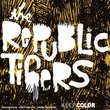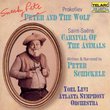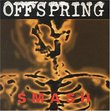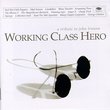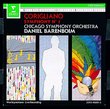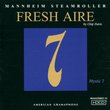| All Artists: Karel Husa, Lawrence Sobol, Orchestra des Soloistes de Paris, Brno State Orchestra Title: Fantasies for Orchestra/The Trojan Women Members Wishing: 0 Total Copies: 0 Label: Phoenix USA Original Release Date: 1/1/1998 Release Date: 1/1/1998 Genre: Classical Styles: Ballets & Dances, Ballets, Chamber Music, Historical Periods, Classical (c.1770-1830), Modern, 20th, & 21st Century Number of Discs: 1 SwapaCD Credits: 1 UPC: 094629301280 |
Search - Karel Husa, Lawrence Sobol, Orchestra des Soloistes de Paris :: Fantasies for Orchestra/The Trojan Women
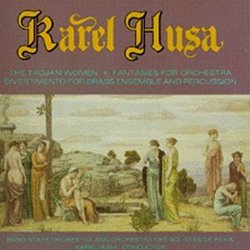 | Karel Husa, Lawrence Sobol, Orchestra des Soloistes de Paris Fantasies for Orchestra/The Trojan Women Genre: Classical
The works on this disc show three different sides of Karel Husa. The Divertimento, written in 1958, is a light, charming piece of Neoclassicism in four brief movements. The more expansive Fantasies for Orchestra from 1956 ... more » |
Larger Image |
CD DetailsSynopsis
Album Description The works on this disc show three different sides of Karel Husa. The Divertimento, written in 1958, is a light, charming piece of Neoclassicism in four brief movements. The more expansive Fantasies for Orchestra from 1956 is one of the composer's finest works, virtually a three-movement symphony. The opening movement brings to mind Bartók, especially in the slow, constantly building passage for strings that occupies its first half. The second movement is an exhilarating dance, based on a two-plus-three rhythm that suggests Eastern European folk music. The Finale is called "Nocturne," and there are once again suggestions of Bartók -- the connections to the latter's night music are obvious -- but far less tense and a bit more lyrical. The scenes from "The Trojan Women" show again a different Husa, quite comfortable with orchestral and compositional techniques of the second half of the century. There are dissonant clusters, a huge percussion battery, and the use of microtones, all of which help to create a score of considerable tension and dramatic power. The piece demonstrates one of Husa's greatest talents, the ability to use effects often associated with more forbidding music in a manner that always remains accessible for the audience. Similarly Requested CDs
|
CD ReviewsNot the best introduction to the music of Karel Husa Discophage | France | 02/28/2007 (3 out of 5 stars) "The small Phoenix label has been very enterprising and helpful in giving a second, CD life to recordings of 20th century American composers (Barber, Rorem, Menotti, Douglas Moore, Irving Fine, Peter Mennin, Lou Harrison, Ezra Laderman, Nicolas Flagello - to which one can add the Argentinean Alberto Ginastera) first published on rather obscure and specialized LP labels, such as Orion or Everest. One related and very welcome reissue has been the 2nd and Pulitzer-Prize winning 3rd String Quartets of Karel Husa, an important recording from the early 70s (see my review of String Quartets No.2 and No.3). In the present case, however, they are really unhelpful and slapdash in providing no recording dates nor any information about the sources of these recordings. One of the most appreciated innovations of the CD over the LP has been to provide that kind of info and, as much as one is grateful to Phoenix for making that kind of material available, one can only chastise them for their sub-par publication standards. Even the brass ensemble conducted by clarinetist Lawrence Sobold in the Divertimento is unnamed. The selected discography contained in the liner notes of the New World Records CD with Husa's 2nd violin sonata and 2nd piano sonata (see my review) refers to it as the New York Brass Ensemble, but I don't know where that info comes from and if it is reliable. The Scenes from "The Trojan Women" must have been recorded somewhere between 1981 (the ballet's first performance) and 1998 (when this CD was issued). As for the Fantasies for orchestra, there is in the Library catalog of Cornell University (where Husa has taught from 1954 to his retirement in 1992) an entry for an LP published by Cornell in 1962, containing what appears to be this very recording, made by the composer with the "Orchestre des solistes de Paris" (and certainly not the comical hodge-podge of French and English "Orchestra des soloistes de Paris" as the Phoenix back cover has it). During his Paris years (around 1954), Husa made two recordings with the cryptic "Orchestre des Cento Soli" (Brahms' first symphony and Bartok's Miraculous Mandarin-Suite and two Rhapsodies for violin with soloist Devy Erlih), and I assume this is the same orchestra.
Anyway, the 1958 Divertimento for brass ensemble and percussion and the 1956 Fantasies for orchestra are not the most typical of their composer - or rather, they are typical of his earlier, not yet mature style. The short brass divertimento (11'), which comes in excellent sound, is couched in a rather anonymous, mildly modern and slightly bombastic "American" idiom; it could be, really, anybody's composition: Morton Gould, Persichetti, Copland, Virgil Thompson, you name it. The second movement, "Little Scherzo", betrays some Bartokian influence - but no more than anybody who'd have studied his scores in those years might have displayed, and as for the fourth movement, I had to read its title, "Slovak Dance", to realize that it was that rather than just any merry, boisterous stars-and-stripes finale. The 20-minute long Fantasies are (very) moderately original in their construction, in that the fast movement (Capriccio) is framed by two slow ones (Aria and Nocturne), all played without interruption. The first movement then is a brooding aria, first uttered by the strings and rising to a climax then receding to its initial calmness. It is reminiscent of the opening of Bartok's Concerto for orchestra or the first movement of the Music for Strings, Percussion and Celesta. The Capriccio could be a Martinu piano concerto - but without the motoric drive so typical of Martinu. More original is the closing Nocturne, again starting softly and rising to a climax, but very subtly orchestrated, in an almost "pointillistic" manner, with a very colorful result. This movement alone - I believe in the same interpretation - had been published on a CRI LP which also had the 1st Symphony and Serenade, the two latter reissued on a now unavailable CRI CD without their filler (see my review). The sound is not as vivid as with the two other pieces, but one adjusts easily. As their title implies (but you've got to go to the back cover for the full title), the Scenes from the ballet "The Trojan Women" are not the 44-minute complete ballet but a 28 minute suite drawn from it. The complete work is featured on a First Edition CD with the Louisville Orchestra under Akira Endo, which I have reviewed (Karel Husa: Two Sonnets from Michelangelo / The Trojan Women). The composer-led Brno orchestra sounds more raw and gruff-colored, with more prominent percussion, than Louisville under Endo - which adds much ominous power in the more violent numbers, like Cassandra's dance (track 9) or The Death of Astyanax (track 11), but at the cost of some refinement, as in the upward scale that ends the prologue (track 8). Hecuba's lullaby to her slaughtered grandson Astyanax (track 10) comes out very well, thanks to the cruder sound of the bamboo flute over bells, making it sound - rather inappropriately to the historical subject but nonetheless interestingly musically - like "Chinese" music. In Louisville the flute was hardly distinguishable from a normal flute, but again the string glissandos were more refined and eerie. The sometimes very descriptive and plot-bound nature of the complete ballet is not so much in evidence in the Scenes, which sound more like Husa's more "abstract" compositions. Still, given that neither the Divertimento nor the Fantasies showcases Husa at his most mature and personal, and that the complete ballet can be found elsewhere and is a preferable representation of the composer, this CD is perhaps not the best introduction to the music of Karel Husa. " |

 Track Listings (3) - Disc #1
Track Listings (3) - Disc #1

